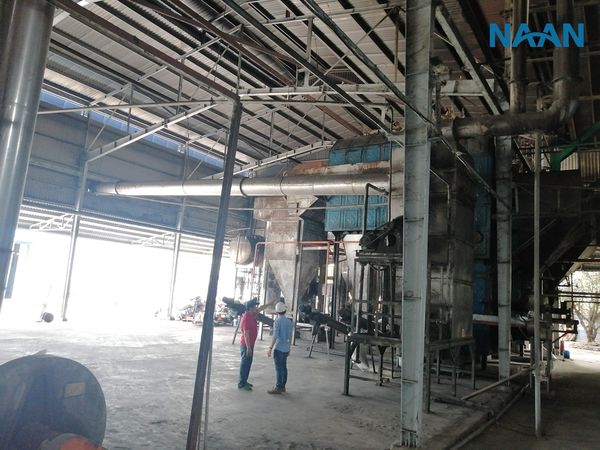Factors affecting boiler performance and measures to improve it

Naan engineers are surveying to improve the efficiency of an old industrial boiler
The efficiency of a boiler is related to many factors such as fuel, operation adjustment, boiler parameters and recovery, and waste heat utilization. There are mainly the following methods to improve the thermal efficiency of boilers:
1. Improve the combustion efficiency of the boiler
The combustion efficiency of the boiler indicates the degree of complete combustion. To improve the combustion efficiency of the boiler, we must try to adjust, organize the combustion conditions in the boiler to completely burn the fuel and reduce q3, q4. Incomplete fuel combustion will increase losses due to incomplete combustion of gas and incomplete combustion of solid, thereby reducing the combustion efficiency of the boiler. There must be three conditions for complete fuel combustion:
- First, there must be enough air, fuel, and air must be thoroughly mixed.
- Second, there must be a sufficiently high furnace temperature for the combustion reaction to occur quickly.
- Third, allow the fuel to stay in the furnace for a certain period of time so that the fuel and oxygen can react completely.
Based on these three conditions, the following measures can be taken to enhance the combustion process.
(1) Adjust the air quantity and provide proper air
Providing proper air is the key to enhancing the combustion process. In mechanized boilers (such as fluidized bed boilers, chain grate boilers, step grate boilers), providing proper air is very important to promote the combustion process in the boiler according to the different characteristics of the combustion process.
(2) Control the excess air coefficient of the furnace
Controlling the excess air coefficient of the furnace is a measure to improve the ability to completely burn fuel and reduce heat loss. If the excess air coefficient of the furnace is too high, the temperature of the furnace will decrease, leading to a decrease in the combustion rate, thereby increasing the losses due to incomplete combustion of gas and incomplete combustion of solid, manifested by the rolling black smoke, high carbon content in the ash, fuel consumption of the boiler… The mass increases and the output decreases significantly. If the excess air coefficient is too low, combustible materials usually cannot be completely burned due to lack of oxygen, which also leads to increased losses due to incomplete combustion of gas and incomplete combustion of solid. Therefore, the excess air coefficient of the furnace is the most economical value, helping to minimize the total q2, q3, q4 is the optimal excess air coefficient. This value can be determined through adjustment tests of the combustion process.
(3) Maintain high temperature in the furnace
Maintaining a high temperature in the furnace is a condition for fast fuel combustion. For biomass-fired furnaces, the temperature in the furnace should be maintained at 800 degrees Celsius. The purpose of maintaining a high temperature in the furnace: first, to increase the rate of chemical reaction in the combustion process and reduce q3 and q4 losses; second, to enhance radiative heat transfer.

Fuel combustion process in the combustion chamber
Measures to maintain a high temperature in the furnace, when burning poor quality fuel, the temperature in the furnace will decrease significantly. In this case, first, fire-resistant bricks or fire-resistant concrete can be used to block part of the radiant heat transfer surface to reduce the degree of cooling of the water in the furnace. Secondly, a preliminary air preheating system can be added to preheat the cold air and introduce it into the furnace to improve the efficiency of the furnace. The heat can both increase the temperature in the furnace and reduce the temperature of the flue gas.
2. Reduce the flue gas temperature
Currently, the flue gas temperature of boilers in our country is relatively high, which is one of the main reasons for the low thermal efficiency of boilers. For every 15-20 degrees Celsius reduction in the flue gas temperature of small boilers and a 15 degrees Celsius reduction for large boilers, the thermal efficiency of the boiler increases by 1%. Therefore, efforts should be made to recover the heat of the flue gas to reduce the flue gas temperature, reduce the q2 heat loss, and save fuel. Common heat recovery devices include water heaters and air dryers. The heat-saving device developed and designed by Naan can significantly reduce the flue gas temperature and improve the thermal efficiency of the boiler.
3. Control the excess air coefficient at the smoke pipe
The increase of the excess air system at the outlet of the furnace and the air leakage in each smoke pipe along the smoke path will increase the excess air coefficient at the smoke pipe, meaning increasing the amount of flue gas and thus increasing the heat loss. To reduce the heat loss of flue gas, on the one hand, the outlet of the furnace must maintain the optimal excess air coefficient, on the other hand, efforts should be made to minimize air leakage from the furnace and each smoke pipe. Air leakage not only increases the volume of flue gas but also increases the temperature of the flue gas. When cold air leaks into the smoke pipe, the temperature of the flue gas at the air leakage point decreases, so the heat absorbed by all the heat transfer surfaces after the air leakage point decreases, thereby increasing the temperature of the flue gas. And the closer the air leakage point is to the furnace, the greater the impact.
Currently, the situation of air leakage in the furnace and smoke pipes of medium and small boilers is very common, which not only increases the amount of smoke but also reduces the temperature of the flue gas, causing disadvantages for the combustion process. Therefore, when detecting air leakage in the furnace and smoke pipes, the leaks should be sealed as soon as possible to control the excess air coefficient at the exhaust area to reduce heat loss.
4. Keep the boiler operating at rated load
The highest thermal efficiency of the boiler is maintained when it is operated at a stable rated load and continuously. The change in the load of the boiler has a great influence on the combustion process, let's take the fluidized bed boiler as an example to analyze. When the boiler is overloaded, the amount of fuel must be increased, the fuel layer thickens, and the air supply also needs to be increased to meet the increased load demand. The thickening of the fuel layer increases the loss of the solid combustion process. Due to the increased volume of flue gas, the heat loss increases, and the incomplete combustion of gas and solid also increases. At the same time, the large load fluctuations of the boiler also lead to frequent changes in the boiler operation parameters such as the temperature and pressure of the furnace, which increases the boiler load and thermal stress of the components, affects the service life of the boiler, and reduces the operating efficiency of the boiler.
5. Adjust the boiler operation to make it run in an economical condition
The boiler must run in an economical condition to maximize the use of energy and reduce the consumption of energy resources. The most important point in boiler operation adjustment is to maintain the boiler operating parameters (such as steam pressure, steam temperature, feedwater temperature, flue gas temperature, etc.) at the most economical value under the premise of ensuring the safe operation of the boiler. And the running condition is relatively stable, avoiding frequent start-stop operation of the boiler, reducing heat loss caused by thermal shock, and prolonging the service life of the boiler.
Implementing the above measures can effectively improve the thermal efficiency of the boiler and save fuel costs. However, it should be noted that in the actual operation process, the thermal efficiency of the boiler cannot be improved solely by optimizing the combustion process. It is necessary to consider comprehensively according to the actual situation of the boiler, and carry out targeted improvement measures based on the actual situation of the boiler to maximize the improvement of the thermal efficiency of the boiler and achieve the purpose of saving energy and reducing consumption.

